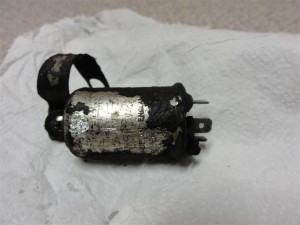
This is the legend on the flasher unit I’ve found in the engine compartment of my London Black Cab. I really want the indicators to work, as I think this is important for passing state inspections, and getting out onto the roads legally.
I love contradictions, or so it would seem if I stop to look at my life for a moment. Part of me screams “sell this car, it’s going to be a constant stream of work”, and part of me loves its quintessential Englishness and can’t bear to see it go.
So do I fix it and drive it around on a regular basis, or do I just drive it outside, take a bunch of photos in/on it and sell it on?
Fixing it might mean nothing more than changing the oil, or it could include everything else:
- making it start more easily – probably fiddling around with glow plugs
- adding AC for the impending absurd temperature and humidity
- work on the clutch – adjust it or replace it
- get it to pass a state inspection
At any rate, I’ve an hour window between the kids falling asleep and me doing the same, and I’m trying to figure why the turn signals aren’t working. It helps me to type what I’m thinking, and I’ve narrowed it down to the following:
- It’s the bulbs. I’ve checked the left hand bulbs and they seem OK.
- It’s the controls. The little switch paddle I’m turning might not actually be for the lights, it might be for something completely different.
- It’s the flasher unit. I’ve dug the one out of the engine compartment and peeled back a few millimeters of indeterminate black grime to reveal the legend LUCAS FLASHER FL512v21. So I figure that’s the unit to test, once I devise a method for doing that.
- It’s the rats’ nest of wiring – helpfully all of the 4 wires going to the unit are green.
- Something I don’t yet know about 1967 turn signal design.
Like some grease bound Indiana Jones I’ve just unearthed the symbols B, P and L on the three terminals of the flasher. According to other flasher units, this probably means: B = Power in, P = feed to warning lamp, L = Flasher signal out.
I also learned that Lucas had a standard wiring color system:
Black: earth, which for my car is the chassis and my system has been converted to 12V.
Green: feeds to devices controlled by ignition, e.g. instruments, flashers and wipers
Red: sidelights and parking / rear lights
Blue and white: full beam headlights
Blue and red: dip beam headlights
Purple: feeds to devices not fed by ignition, e.g. interior lights (like the suckers that always stay on and drain your battery if you leave the door ajar) and horn.
Brown: main battery feed
White: ignition circuit
I’ll see how far I can get in the next hour or so. I would like to at least drive it down to Full English to complete the ex-pat stereotype and try the breakfast. Though it may be the dog days of summer before I get there at one hour per week.

Argh. So it turns out if you go to your cheap parts store and get the $4 flasher, the nomenclature is different. I’ve got P, X, L for Pilot, Input and Load.
So I’m going to try connecting
P == P
B == X
L == L
To see what I can get to smoke. Or flash.
OK. so the flasher works! After owning the car for about 17 days, I have managed to get two lights to flash (the bunny ears). The lights on the front wheel arches don’t seem to do anything, if indeed they’re supposed to. And now I realize that the rear right running light, doesn’t run.
OMG. After a few wiring changes, and ignoring the irrational behaviour of the lights, I’ve now got the running lights running. To keep them running requires occasional pokes at the fuse box under the bonnet. The wiring is all just so very tenuous. Electricity seems to flow in response to commands of ghost of engineers past, willing the current to breech bizarre connections from beyond the grave.